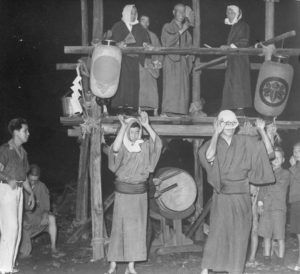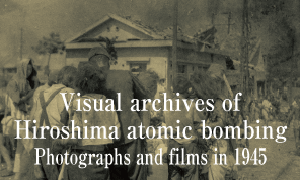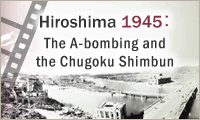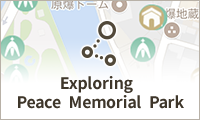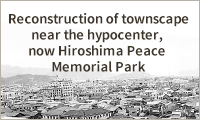Documenting Hiroshima of 1946: June 4, Toka Festival held to console souls of those killed in war
Jun. 4, 2025
by Maho Yamamoto, Staff Writer
On June 4, 1946, an annual early summer event, the “Toka Festival,” took place at Enryuji Temple in Hiroshima’s Mikawa-cho (now part of Naka Ward), located about one kilometer from the hypocenter. Residents gathered for the festival, which has been held since before the atomic bombing, and danced praying for the souls of those killed in the war.
The June 6 issue of the Chugoku Shimbun introduces the festival with a photograph, reporting: “People dance, moving their hands and legs, and the short night of early summer goes on with the rustic sound of drumming.” The photograph shows the yagura stage set up in the temple grounds, along with a drum and paper lanterns.
June 4 was Tango-no-sekku, the day celebrating the Boy’s Festival, in the lunar calendar. Koin Nakatani, 41, the chief priest of the temple, imagines the time and says: “It is a festival to welcome early summer. People might have found a reason to live by feeling the four seasons through the Toka Festival.” The temple grounds were four times larger back then, big enough to hold the festival within the precincts.
On August 6, 1945, the blast and thermal rays from the atomic bomb completely destroyed and incinerated all the buildings in the area. At that time, a small branch school of Takeya National School (now Takeya Elementary School) and Fukuromachi National School (now Fukuromachi Elementary School) was situated in Enryuji Temple, with an enrollment of about 20 to 30 pupils. Most of them lost their lives in the bombing.
Mr. Nakatani’s great-grandfather, Jikyo (died in 1951 at the age of 56), was the chief priest at the time of the bombing. He escaped death because he was at the Hijiyama Military Cemetery (now located in Minami Ward) to hold a morning memorial service. He began restoring the temple around that fall, building a temporary main hall.
Nagaakira Asano, the first lord of the former Hiroshima domain, established Enryuji Temple at its present site in 1619. Instead of Inari Daimyojin (‘the Great God Inari’), he called the object of worship Toka Daimyojin. The kanji for “Toka” and “Inari” are the same, but “Toka” is the Chinese reading, while “Inari” is the native Japanese reading. The festival is said to have begun in May of the following year, with wishes for the safety of the samurais and the well-being of the people.
Until 1954, the festival was held on Tango-no-sekku day according to the lunar calendar. After that, the dates and duration of the festival varied, with the permutation of the solar calendar, its positive economic effect on the surrounding area, and the rainy season being taken into consideration. The current three-day event, held from the first Friday in June, has been established since 1998. With over 400 years of history, the festival draws crowds of 450,000. It is scheduled to take place from June 6 to 8 this year.
(Originally published on June 4, 2025)
On June 4, 1946, an annual early summer event, the “Toka Festival,” took place at Enryuji Temple in Hiroshima’s Mikawa-cho (now part of Naka Ward), located about one kilometer from the hypocenter. Residents gathered for the festival, which has been held since before the atomic bombing, and danced praying for the souls of those killed in the war.
The June 6 issue of the Chugoku Shimbun introduces the festival with a photograph, reporting: “People dance, moving their hands and legs, and the short night of early summer goes on with the rustic sound of drumming.” The photograph shows the yagura stage set up in the temple grounds, along with a drum and paper lanterns.
June 4 was Tango-no-sekku, the day celebrating the Boy’s Festival, in the lunar calendar. Koin Nakatani, 41, the chief priest of the temple, imagines the time and says: “It is a festival to welcome early summer. People might have found a reason to live by feeling the four seasons through the Toka Festival.” The temple grounds were four times larger back then, big enough to hold the festival within the precincts.
On August 6, 1945, the blast and thermal rays from the atomic bomb completely destroyed and incinerated all the buildings in the area. At that time, a small branch school of Takeya National School (now Takeya Elementary School) and Fukuromachi National School (now Fukuromachi Elementary School) was situated in Enryuji Temple, with an enrollment of about 20 to 30 pupils. Most of them lost their lives in the bombing.
Mr. Nakatani’s great-grandfather, Jikyo (died in 1951 at the age of 56), was the chief priest at the time of the bombing. He escaped death because he was at the Hijiyama Military Cemetery (now located in Minami Ward) to hold a morning memorial service. He began restoring the temple around that fall, building a temporary main hall.
Nagaakira Asano, the first lord of the former Hiroshima domain, established Enryuji Temple at its present site in 1619. Instead of Inari Daimyojin (‘the Great God Inari’), he called the object of worship Toka Daimyojin. The kanji for “Toka” and “Inari” are the same, but “Toka” is the Chinese reading, while “Inari” is the native Japanese reading. The festival is said to have begun in May of the following year, with wishes for the safety of the samurais and the well-being of the people.
Until 1954, the festival was held on Tango-no-sekku day according to the lunar calendar. After that, the dates and duration of the festival varied, with the permutation of the solar calendar, its positive economic effect on the surrounding area, and the rainy season being taken into consideration. The current three-day event, held from the first Friday in June, has been established since 1998. With over 400 years of history, the festival draws crowds of 450,000. It is scheduled to take place from June 6 to 8 this year.
(Originally published on June 4, 2025)

